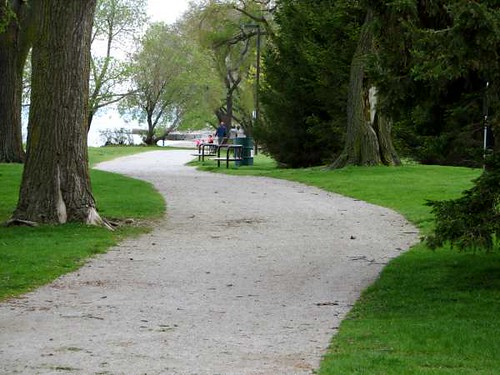- Think Walk - pose a “big idea” question for students to consider while you lead them on a 10 minute walk. 10 minutes of movement and a change of context will lead to a richer discussion and better retention. After the walk ask the students to work in triads to develop a common answer to the initial question to share with the class.
- Observation Challenge - lead students on a 10 minute walk outside. Notice 5-10 details while you walk. Challenge the students to pay attention to their surrounding while they walk. When you return to class pose questions based on the details observed during the walk (e.g. “How many people were sitting on the grass by the track?” / “What colour was the car parked beside the door we exited?” / “What kinds of flowers were growing in the garden we walked past?”) -- Useful activity for poetry study or narrative writing.
- Inside Circle / Outside Circle - move the class outside and form two concentric standing circles. The members of the inner circle face the members of the outer circle. Provide a big idea prompt to the inner circle students (e.g. - “justify your choice for the most interesting text we’ve read in class this year” / “explain which character from a text you’ve read this year would be the most interesting to meet” / “explain why a sequel should be developed for one of the texts that we’ve read this year”). Rotate the outer circle two places and repeat with the member of the outer circle speaking. Repeat a few times. Great review or consolidation activity. Alternative context helps with retention. Standing promotes focus.
- Character Walk - ask the students to choose one of the characters from a text they’re reading. Lead students on a short walk. Challenge the students to walk in trios and to adopt the traits of their chosen character and to have a conversation in character while they walk. Give the trios a minute to brainstorm a topic for their conversation before you leave. When you return ask the students to report on how they used word choice, body language and specific ideas to bring their characters to life.
- Context Circle - move the class outdoors for a circle on the grass. Set the context for the lesson or activate students' prior knowledge with a prompt (e.g. - what’s something you already know about…”). The alternate context and circle can improve focus and give all students a voice.
- Writing Instructions / Procedures - select a few specific destinations on the school grounds. In small groups challenge the students to develop very specific language to direct a person to their assigned destination -- with the one complication that they can only direct movement not describe the destination (e.g. - “Walk to the west end of the hallway and turn left…” NOT “If you’re standing under the goal posts you’re in the right place”). Have the groups trade instructions and see if they can successfully follow the other group's instructions.
- Artifact Circle - ask students to bring artifacts from home (nothing valuable) that connect to a text that has been studied in class this year. Sitting on the grass in small circles of 6-8 ask the students to pass around the artifacts and make connections to the texts read in class. The student who provided the artifact goes last to explain the connection he/she intended the artifact to represent. Challenge the students to extend their understanding by making deeper connections to their texts and speculating how characters in their texts might participate in this experience.
- Photo Hunt - lead students on a walk. During the walk, challenge the students to find or stage a photo that connects to a text that you’ve read / viewed in class. When you return to class jigsaw the class and have students share / explain their images.
- Exam Prediction Brainstorm - lead the students on a walk. While walking ask the students to brainstorm a question that “should” appear on the final exam about one of the texts being studied in class. Prior to the walk co-create the criteria that you would use to describe an appropriate exam question. After the walk jigsaw a sharing of the questions.
- Be Miserable - on a lousy weather day take students outside (briefly?). When you return to class ask the students to individually write a reflection or hold a whole class circle discussion about how the weather affects them. Make connections to the use of setting in a text or brainstorm ideas of how to overcome negative feelings about the weather and discuss how these strategies could have been used by a character in a text studied in class.
Thursday, May 28, 2015
10 Ideas To Get Your Class Outdoors
Subscribe to:
Post Comments (Atom)
Featured Post
Critical literacy lesson:
Poor Journalism: " Rise of women teachers 'turning boys off education' as report reveals girls born this year will be 75%...


No comments:
Post a Comment